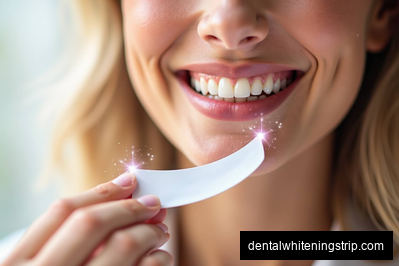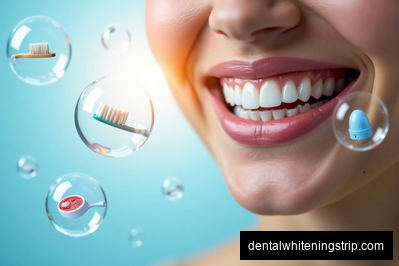Introduction
Everyone desires a bright smile. It's a universal symbol of health and beauty. But due to our dietary habits and age, our teeth can lose their natural whiteness. Thanks to advancements in dental technology, achieving that coveted pearly white smile is possible. This article will explore the world of teeth whitening, focusing on dental strips and how they compare to other methods.
According to the American Academy of Cosmetic Dentistry, Americans spend over $1.4 billion on over-the-counter teeth whitening products each year. As the demand for whiter teeth increases, so do the options for achieving it. So let's dive into this complex world and find the best solution for you.
In delving deeper into the realm of dental aesthetics, the importance of oral hygiene cannot be overstated. Beyond just the quest for a dazzling smile lies a crucial foundation in maintaining overall health and well-being. Imagine the impact of neglected oral care on one's self-esteem and confidence, hindering social interactions and professional opportunities. By emphasizing the significance of routine dental check-ups, proper brushing techniques, and the avoidance of sugary foods, individuals can take proactive steps towards achieving not only a radiant smile but also a healthier lifestyle.
Understanding Dental Strips
Dental strips, also known as whitening strips, are thin, flexible strips coated with a peroxide-based whitening gel. They are applied to the teeth for a specific period, typically 30 minutes to an hour, and are used once or twice a day for two weeks. This method is popular due to its convenience and affordability.
Clinical studies, like one published in the Journal of the American Dental Association, show that whitening strips effectively lighten teeth by 1-2 shades. However, their performance can be limited by factors such as tooth discoloration severity and individual oral health conditions.
Understanding dental strips goes beyond their whitening capabilities. These strips are designed to conform to the shape of your teeth, ensuring even application of the whitening agent. Additionally, some dental strips contain ingredients like fluoride to provide extra benefits such as strengthening enamel and reducing sensitivity. It's important to follow the instructions carefully to achieve optimal results without harming your teeth or gums. By grasping the intricacies of how dental strips work and their components, you can make informed decisions about incorporating them into your oral care routine.
Other Whitening Methods
Teeth whitening options aren't limited to dental strips. They range from home remedies to professional treatments, each with its own set of pros and cons. Home remedies like a baking soda and hydrogen peroxide paste are affordable but offer limited results. On the other hand, professional whitening treatments provide dramatic results, but they often come with a hefty price tag.
For instance, in-office bleaching, also known as chairside bleaching, involves applying a strong bleaching agent to the teeth and activating it with light or heat. This method can lighten teeth by several shades in just one session. However, it can cost several hundred dollars per session.
In addition to dental strips, there are innovative whitening methods gaining popularity. LED teeth whitening, for instance, utilizes light technology to accelerate the whitening process, offering quick and effective results. Another emerging trend is charcoal toothpaste, known for its ability to remove surface stains and brighten teeth naturally. Moreover, some individuals opt for whitening pens, convenient tools that allow for targeted application on specific areas. These alternative methods provide diverse options for individuals seeking a brighter smile beyond traditional treatments.
Comparing Dental Strips to Other Methods
When comparing dental strips to other methods, it's essential to consider effectiveness, cost, and convenience. Dental strips are less expensive than professional treatments and more effective than most home remedies. However, they require consistent use over a couple of weeks to achieve noticeable results.
On the other hand, professional treatments provide immediate, dramatic results but at a significantly higher cost. Home remedies are the most affordable but least effective option. It's also important to note that all teeth whitening methods can cause tooth sensitivity, with the severity depending on the method used and the individual's oral health.
While dental strips are convenient for whitening, some may prefer professional dental treatments for more advanced issues. For instance, dental bonding is ideal for correcting chips or gaps, offering a more permanent solution than strips. Additionally, laser whitening treatments provide quick results for those seeking immediate improvements. However, the cost of these procedures can be significantly higher compared to dental strips, making them less accessible for some individuals. Understanding the differences in effectiveness, cost, and longevity can help individuals choose the best method suited to their dental needs.
Making the Right Choice for You
Choosing the right teeth whitening method depends on your budget, time commitment, and desired results. If you're looking for a cost-effective solution and can dedicate a couple of weeks to the process, dental strips might be the best option for you.
However, if you desire immediate results and don't mind investing more money, a professional treatment might be more suitable. Remember, it's always best to consult with a dental professional before starting any teeth whitening regimen to ensure you're choosing the safest and most effective solution for your specific needs.
When it comes to making the right choice for your teeth whitening journey, it's essential to consider not just the immediate results but also the long-term impact on your oral health. For instance, while over-the-counter whitening strips may seem cost-effective initially, visiting a professional dentist for a custom treatment plan can provide more tailored results and minimize potential risks. Remember, each person's dental needs are unique, so taking the time to weigh the options based on your individual circumstances can lead to a more satisfying outcome in the end.
Conclusion
Navigating the world of teeth whitening can be complex, with multiple options available, each with its own set of pros and cons. Dental strips have emerged as a popular choice due to their balance of cost-effectiveness and performance. However, other methods, such as professional treatments and home remedies, might be more suitable depending on individual circumstances.
Ultimately, the best teeth whitening method is the one that fits your budget, lifestyle, and dental health. Therefore, always consult with a dental professional before embarking on your journey to a whiter smile.
In conclusion, after exploring the various teeth whitening options, it's essential to consider your individual needs and preferences. Whether you opt for professional treatments like in-office whitening or choose at-home solutions such as whitening strips or trays, knowing what works best for you is key. Additionally, understanding the potential risks and benefits associated with each method can help you make an informed decision. Remember, achieving a brighter smile is a journey that requires careful consideration and consultation with dental professionals to ensure safety and effectiveness.









